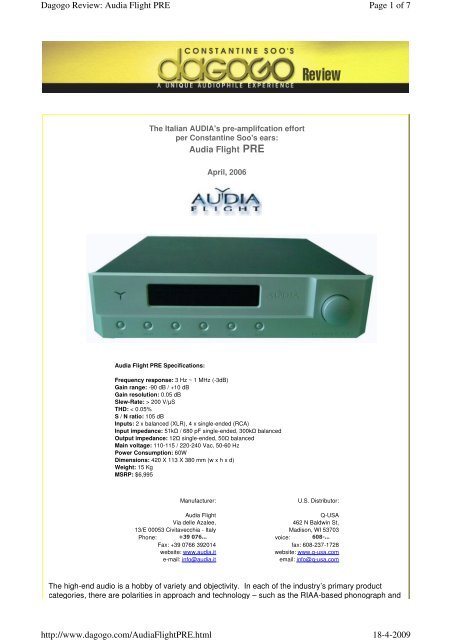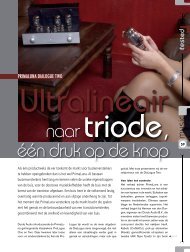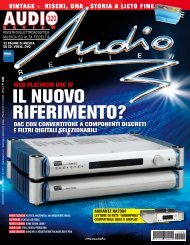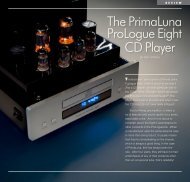Audia Flight PRE Page 1 of 7 Dagogo - Durob Audio
Audia Flight PRE Page 1 of 7 Dagogo - Durob Audio
Audia Flight PRE Page 1 of 7 Dagogo - Durob Audio
You also want an ePaper? Increase the reach of your titles
YUMPU automatically turns print PDFs into web optimized ePapers that Google loves.
<strong>Dagogo</strong> Review: <strong>Audia</strong> <strong>Flight</strong> <strong>PRE</strong><br />
The Italian AUDIA's pre-amplifcation effort<br />
per Constantine Soo's ears:<br />
<strong>Audia</strong> <strong>Flight</strong> <strong>PRE</strong><br />
<strong>Audia</strong> <strong>Flight</strong> <strong>PRE</strong> Specifications:<br />
April, 2006<br />
Frequency response: 3 Hz ~ 1 MHz (-3dB)<br />
Gain range: -90 dB / +10 dB<br />
Gain resolution: 0.05 dB<br />
Slew-Rate: > 200 V/µS<br />
THD: < 0.05%<br />
S / N ratio: 105 dB<br />
Inputs: 2 x balanced (XLR), 4 x single-ended (RCA)<br />
Input impedance: 51kΩ / 680 pF single-ended, 300kΩ balanced<br />
Output impedance: 12Ω single-ended, 50Ω balanced<br />
Main voltage: 110-115 / 220-240 Vac, 50-60 Hz<br />
Power Consumption: 60W<br />
Dimensions: 420 X 113 X 380 mm (w x h x d)<br />
Weight: 15 Kg<br />
MSRP: $6,995<br />
Manufacturer:<br />
<strong>Audia</strong> <strong>Flight</strong><br />
Via delle Azalee,<br />
13/E 00053 Civitavecchia - Italy<br />
Phone: +39 076...<br />
Fax: +39 0766 392014<br />
website: www.audia.it<br />
e-mail: info@audia.it<br />
U.S. Distributor:<br />
Q-USA<br />
462 N Baldwin St,<br />
Madison, WI 53703<br />
voice: 608-...<br />
fax: 608-237-1728<br />
website: www.q-usa.com<br />
email: info@q-usa.com<br />
<strong>Page</strong> 1 <strong>of</strong> 7<br />
The high-end audio is a hobby <strong>of</strong> variety and objectivity. In each <strong>of</strong> the industry’s primary product<br />
categories, there are polarities in approach and technology – such as the RIAA-based phonograph and<br />
http://www.dagogo.com/<strong>Audia</strong><strong>Flight</strong><strong>PRE</strong>.html<br />
18-4-2009
<strong>Dagogo</strong> Review: <strong>Audia</strong> <strong>Flight</strong> <strong>PRE</strong><br />
categories, there are polarities in approach and technology – such as the RIAA-based phonograph and<br />
the 16-bit/44.1kHz-based digital playback systems, MOSFET and tube-based amplifications, and<br />
finally,<br />
cone and planar loudspeaker technologies – that the proponents for each consider indispensable and<br />
superior. Yet, there is one component type that everyone has contemplated getting rid <strong>of</strong> one way or<br />
the<br />
other, and it is the preamplifier.<br />
Transistor or tube, line preamplifiers have always occupied a bittersweet spot in everyone’s heart,<br />
considering its property for either making or breaking a system from the level <strong>of</strong> synergy created. To<br />
many<br />
audiophiles, brackets <strong>of</strong> price range represent a safe route for matching components: budget<br />
components<br />
dominate the sub-$2,000 range, while high-performance ones reside in the $9k+; and any higher would<br />
be<br />
considered exotic by many.<br />
<strong>Audio</strong>philes contemplating the purchase <strong>of</strong> either $2,000 or $50,000 line preamplifiers have an easier<br />
time than those <strong>of</strong> us considering a $7k one, for the polarity in prices provides clarity and guideline in<br />
respective buyers’ decision-making process, at the same time represent an approximate indicator for<br />
system matching; while a $7,000 line preamplifier falls into a somewhat grayish area.<br />
If one has a $10,000 power amplifier <strong>of</strong> commendable performance, then a $20,000 preamp <strong>of</strong><br />
competent<br />
caliber may continue to compliment the power amplifier’s inherent strength. However, a $7k<br />
preamplifier<br />
would likely accentuate the relative weakness <strong>of</strong> a $3,000 power amplifier that was designed to a<br />
budget,<br />
<strong>Page</strong> 2 <strong>of</strong> 7<br />
The <strong>PRE</strong> is one <strong>of</strong> a kind in being given three 10,000 Gauss toroidal transformers mounted upside<br />
down<br />
at the lower half <strong>of</strong> the chassis into the centrally positioned circuit board. Among the toroidals, two are<br />
rated at 50VA each for stereophonic reproduction, and one at 30VA for control logics. The upper<br />
section<br />
is consisted strictly <strong>of</strong> the main audio board.<br />
To generate a 50V output for each channel, the dual-mono transformers are flanked by four “Ultra Fast<br />
Recovery” diodes and eight 3,300µF, 63V ROE-EYS series filtering capacitors. In addition, to ensure<br />
the<br />
integrity <strong>of</strong> each channel’s signal during internal propagation between circuitry sections, four dual<br />
discrete<br />
stages are provided, amounting to an unheard <strong>of</strong> total <strong>of</strong> 18 discrete stages for each channel.<br />
With such vigor, the <strong>PRE</strong> is then class A-biased and regulated by <strong>Audia</strong>’s current-feedback technique.<br />
Contrary to the widely adopted voltage feedback technique, which yields lower levels <strong>of</strong> input noise and<br />
http://www.dagogo.com/<strong>Audia</strong><strong>Flight</strong><strong>PRE</strong>.html<br />
18-4-2009
<strong>Dagogo</strong> Review: <strong>Audia</strong> <strong>Flight</strong> <strong>PRE</strong><br />
Contrary to the widely adopted voltage feedback technique, which yields lower levels <strong>of</strong> input noise and<br />
low frequencies distortion, current feedback provides unlimited slew rate and wide bandwidth.<br />
<strong>Audia</strong>’s implementation <strong>of</strong> the current feedback culminated supposedly in a high-current, low-noise<br />
output<br />
The <strong>PRE</strong> chassis is machined out <strong>of</strong> aluminum via Numerical Control (NC) units and laser machines.<br />
NC<br />
micro millers further crafted the front panel out <strong>of</strong> a 25mm thick aluminum ingot. Chassis-width<br />
damping<br />
plates are inserted under the top cover, as well as between the two boards. To root out possible<br />
interference, the logic control circuitry is encased in metal and positioned behind the front panel.<br />
Fully equipped and intended to be used as a reference preamplifier, the <strong>PRE</strong> is adorned with four RCA<br />
and two XLR inputs, along with one RCA Record output, one RCA Main output and one XLR Main<br />
An aluminum, milled remote control mimics all<br />
functions on the <strong>PRE</strong>’s front panel, except for REC:<br />
the record monitor. A SET button on the remote<br />
further enables customization <strong>of</strong> input gains and<br />
input<br />
http://www.dagogo.com/<strong>Audia</strong><strong>Flight</strong><strong>PRE</strong>.html<br />
<strong>Page</strong> 3 <strong>of</strong> 7<br />
The <strong>PRE</strong>’s front panel sports dainty, tidy lines, with<br />
beautifully subtle curves. Embedded into this<br />
tastefully crafted front panel are, from left to center<br />
right, ON/OFF, INPUT, REC, DIM, BAL and MUTE.<br />
On the right is a large dial for setting <strong>of</strong> each<br />
aforementioned control, in addition to being the<br />
attenuator. At upper center left is the large display,<br />
the brightness <strong>of</strong> which can be trimmed or defeated<br />
18-4-2009
<strong>Dagogo</strong> Review: <strong>Audia</strong> <strong>Flight</strong> <strong>PRE</strong><br />
input<br />
characterization. Despite repeated attempts and<br />
examinations on my part, the <strong>PRE</strong> would not<br />
reconfigure its operational mode into the "Single-<br />
Finally, the <strong>PRE</strong> is to be left in the blinking, standby mode when not in active use, in which the<br />
amplification<br />
stages remain powered, and the attenuation at minus-117.5db. Once powered on, the attenuation<br />
adjusts<br />
itself instantly, with the display jumping from -117.5dB to the former level prior to the shutdown.<br />
Input gain can be adjusted plus and minus 6dB to facilitate uniform volume, and each input can be<br />
custom<br />
named with a maximum <strong>of</strong> 13 characters. Display brightness can be dimmed through 5 levels,<br />
including<br />
my favorite one, display <strong>of</strong>f.<br />
THE SOUND<br />
To gauge the finesse <strong>of</strong> the <strong>Audia</strong> <strong>Flight</strong> <strong>PRE</strong>, DACs from both solid-state and tube camps were<br />
mobilized, including my longstanding champion <strong>of</strong> DACs, the $30k tubed <strong>Audio</strong> Note DAC5 Special,<br />
and<br />
the best solid-state DAC I’ve heard to date, the $5,700, 32bit/384kHz Accustic Arts DAC I Mk3.<br />
Primary<br />
amplification was via <strong>Audia</strong>’s own $11k <strong>Flight</strong> 100, a 32-IGBT-equipped current-feedback design <strong>of</strong><br />
superlative finesse, which I reviewed in October, 2005. 47 Lab’s PiTracer helmed the tracing <strong>of</strong> pits<br />
from<br />
CDs.<br />
The <strong>Flight</strong> 100’s high-power, high-current capacity facilitated auditioning via a variety <strong>of</strong> loudspeaker,<br />
thus<br />
the 89dB/4Ω, $12k GamuT L5, the 95dB/8Ω, $20k <strong>Audio</strong> Note AN-E SEC Silver and the 93dB/8Ω, $26k<br />
Acapella La Campanella were the primary speakers rotated for this review.<br />
Many audiophiles prefer tube preamps for the nonexistent tonal artificiality and graininess that solidstate<br />
preamps are known to impart, especially in reproducing vocals. Atop a platform <strong>of</strong> its companion <strong>Flight</strong><br />
100 amplifier and GamuT’s L5 loudspeaker, the <strong>PRE</strong>’s manifestation <strong>of</strong> tenor Toby Spence’s “Vallon<br />
Sonore” [O echoing vale] from the Berlioz opera Les Troyens [The Trojans] (LSO 0010 CD) via the<br />
CDs produced prior to the common high-bit<br />
remastering <strong>of</strong> late, such as my favorites from<br />
Deutsche Grammophon and Philips, consistently<br />
demonstrated less refined tonal balance with<br />
pronounced top-end carelessness via the <strong>PRE</strong> –<br />
a<br />
sharp contrast to the absence <strong>of</strong> such inherent<br />
information as rendered by lesser amplification<br />
designs. Accordingly, sonics from archaic CDs<br />
processed with comparatively primitive standards<br />
were consistently found wanting in the presence<br />
<strong>of</strong><br />
the <strong>PRE</strong>.<br />
Also noteworthy was the <strong>PRE</strong>’s highly<br />
revealed the GamuT L5’s soundstaging prowess as the most differing from what the Acapella La<br />
http://www.dagogo.com/<strong>Audia</strong><strong>Flight</strong><strong>PRE</strong>.html<br />
<strong>Page</strong> 4 <strong>of</strong> 7<br />
18-4-2009
<strong>Dagogo</strong> Review: <strong>Audia</strong> <strong>Flight</strong> <strong>PRE</strong><br />
revealed the GamuT L5’s soundstaging prowess as the most differing from what the Acapella La<br />
Campanella could single-handedly achieve. During a separate session with one <strong>Audio</strong> Note M8<br />
preamp<br />
($31,750), the GamuT’s soundstage expansiveness and 3-dimensionality was contrasted most<br />
explicitly<br />
by the Acapella’s full-range rendition <strong>of</strong> instrument tonality. To hear a $7k solid-state preamp being<br />
able<br />
to trail in the same direction was most riveting.<br />
On dynamics, the <strong>PRE</strong>’s handling <strong>of</strong> the signal from the solid-state Accustic Arts DAC was also to be<br />
applauded for its ability to track the scales <strong>of</strong> dynamics most diligently.<br />
The Italian preamplifier’s reenactment <strong>of</strong> Anne Weerapass singing the Cole Porter classic, “Night &<br />
Day”<br />
(Out Of Nowhere, Jazznote 170702-02-2), delicately preserved the sound engineer’s intent in the<br />
highly<br />
dynamic, resolving and yet well-balanced vocalization amidst the jazz band in the background.<br />
Transistor<br />
preamplifiers I owned in the past tended to smudge the differentiation between fore- and background.<br />
Per <strong>PRE</strong>, the Harmonix Reimyo SET was able to<br />
display its standard compliment <strong>of</strong> sonic feat<br />
through the $26k Acapella La Campanella horn<br />
speakers, demonstrating a full suite <strong>of</strong> tonal<br />
vibrancy with no sonic detriment that lesser solid-<br />
state preamplifiers would have impeded upon.<br />
Resultantly, the German horn speakers produced<br />
the most effectuating spectral uniformity, with<br />
integrated spectral liquidity and tonal lucidity so<br />
resplendent as to redefine what today’s horn<br />
speakers could accomplish.<br />
In comparison to the now-defunct Reference<br />
Line’s<br />
passive preamplifier, the <strong>PRE</strong> established itself as the first solid-sate active preamp in my system<br />
conceding to zero percent <strong>of</strong> loss in resolving power, at the same time summarily eclipsing the<br />
Reference<br />
Line in dynamic vigor and soundstaging, along with superior consistency in tonal shading at all relevant<br />
volumes.<br />
SUMMARY<br />
With the <strong>Flight</strong> <strong>PRE</strong>, <strong>Audia</strong> demonstrated the pinnacle in solid-state preamplification design.<br />
<strong>Page</strong> 5 <strong>of</strong> 7<br />
Constructed with attenuation cells and relays for maintaining constant impedance, with the ability to<br />
preserve the same frequency response at any attenuation value, the <strong>Audia</strong> <strong>Flight</strong> <strong>PRE</strong> was a precision<br />
device <strong>of</strong> a most spectacular order. It possessed a spectral uniformity <strong>of</strong> such delicacy as to be highly<br />
conducive towards tonal differentiation.<br />
Though <strong>of</strong> solid-state birthright, the <strong>Audia</strong> <strong>Flight</strong> <strong>PRE</strong>’s exceeding resolution and bandwidth propagated<br />
a<br />
sonic presentation that was the antithesis <strong>of</strong> yesterday’s solid-state preamplifiers. In manifesting<br />
powerful<br />
showcases <strong>of</strong> dynamics, delicate texturing and extended spectral reproduction, it traverses alongside<br />
the<br />
$10,000 <strong>Audio</strong> Note M5, complete with a level <strong>of</strong> resolution I’ve yet to experience from another solidstate<br />
http://www.dagogo.com/<strong>Audia</strong><strong>Flight</strong><strong>PRE</strong>.html<br />
18-4-2009
<strong>Dagogo</strong> Review: <strong>Audia</strong> <strong>Flight</strong> <strong>PRE</strong><br />
state<br />
preamplifier.<br />
In addition, it did not constitute the minutest in sonic contamination or deviation. In fact, as proven by<br />
its<br />
coupling to the $24k Harmonix Reimyo PAT-777 300B tube amplifier, the <strong>Audia</strong> <strong>Flight</strong> <strong>PRE</strong>’s<br />
fundamental<br />
lack <strong>of</strong> coloration and distortion illuminated its brilliance, as to be the one solid-state preamplifier<br />
exceedingly conducive in driving the SET amplifier. Then, its regal spectral composure and dynamic<br />
prowess, when driving the matching, $11k <strong>Audia</strong> <strong>Flight</strong> 100, was <strong>of</strong> statutory achievement – amazing<br />
and<br />
breathtaking in action.<br />
ALSO SEE THE DAGOGO REVIEWS OF<br />
47 Laboratory 4704 PiTracer<br />
CD transport<br />
Acapella La Campanella<br />
horn speaker<br />
Accustic Art DAC I Mk3<br />
Harmonix Reimyo PAT-777<br />
300B SET stereo power amplifier<br />
Please Send Us Your Feedback<br />
Your name:<br />
*<br />
Email:<br />
*<br />
Company:<br />
Job title:<br />
Subject:<br />
* Required Field<br />
<strong>Audia</strong> <strong>Flight</strong> <strong>PRE</strong> Review<br />
Questions, comments, or feedback:<br />
*<br />
http://www.dagogo.com/<strong>Audia</strong><strong>Flight</strong><strong>PRE</strong>.html<br />
Send Feedback Reset<br />
DAGOGO© 2006<br />
<strong>Page</strong> 6 <strong>of</strong> 7<br />
18-4-2009
<strong>Dagogo</strong> Review: <strong>Audia</strong> <strong>Flight</strong> <strong>PRE</strong><br />
http://www.dagogo.com/<strong>Audia</strong><strong>Flight</strong><strong>PRE</strong>.html<br />
<strong>Page</strong> 7 <strong>of</strong> 7<br />
18-4-2009






